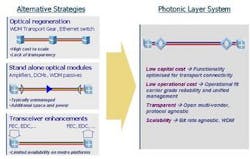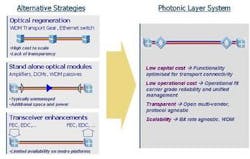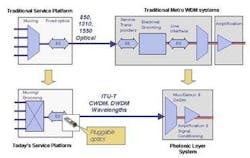Gigabit and 10-Gigabit Ethernet link extension for the metro network
While there are several approaches to extend transmission distances in metro networks, exploitation of the photonic layer represents the most cost-effective option.
By Marc Verreault and Robin Andrew
BTI Photonic Systems
Ethernet is rapidly spreading from the enterprise LAN to the metropolitan environment. Interconnection of data centers, storage connectivity, and Ethernet services are all driving the need to connect business sites across the metropolitan area using Gigabit Ethernet (GbE) and increasingly 10-Gigabit Ethernet (10GbE) links.
With growing customer demand -- driven by high-bandwidth applications such as data storage backup, video on demand, and grid computing -- service providers now face the challenge of providing cost-effective, broadband Ethernet accessibility and connectivity. This has driven a gradual adoption of optical transport technology (such as higher-performance optical transceivers and WDM systems) as a means to implement link connectivity and capacity expansion within the metro core.
Requirement for GbE and 10GbE link extension
Standard Ethernet interfaces, having originally been designed for LAN environments, cannot readily extend across metropolitan distances. To maintain and grow their customer base, network operators require low-cost GbE and, increasingly, 10GbE connectivity that provides complete metropolitan coverage, often involving distances of 50-150 km. For maximum return on investment (ROI), service providers must maximize the addressable market to reach critical enterprise data centers, new customers, and hand-off points throughout the metro. Is there a cost-effective way for network operators to extend GbE and 10GbE links?
A promising approach is the use of coarse WDM (CWDM) and DWDM small-form-factor pluggable (SFP) transceivers and 10-Gbit/sec SFPs such as the XFP, which are becoming available in a variety of optical performance categories. However, while typical SFPs in this class can now extend GbE and 10GbE transport to distances of up to 40-80 km, metropolitan links must frequently extend beyond the 80 km reach of typical link and dispersion budgets. Also, the high optical losses associated with metropolitan fiber networks can easily limit link connectivity to less than the specified reach of transceivers. As SFPs can't solve it all, especially as service providers seek to optimize the performance of installed bases that may not always be compatible with SFP technology, the link extension problem must thus be approached from a broader perspective.
Link extension considerations
Extension of metro Ethernet links should align with the core values of Ethernet -- ubiquitous, low cost, and scalable. Service providers need a simple solution to stretch Ethernet across metro and regional distances to achieve maximum revenue while minimizing cost of ownership. To realize this, a viable extension strategy must have the following attributes
- Low capital cost: Design for modularity enabling a scalable cost structure that does not require an initial extensive outlay of network equipment.
- Low operational cost: Fit with current operational requirements to minimize operational cost. Service velocity features (such as remote provisioning and management) are also needed to enable predictable cost modeling for building, managing, and operating Ethernet link extension systems.
- Transparent: Enable the extension of both GbE and 10GbE (WAN PHY and LAN PHY) interface formats without requiring any form of manipulation to the payload.
- Scalable: Enable in-service bandwidth scalability from GbE to 10GbE as well as the in-service addition of new GbE and 10GbE links along the same routes in the network.
Several approaches are possible to enable Ethernet extension within the metro (Figure 1). These include, but are not limited to, electrical-optical-electrical (OEO) regeneration, optical amplification and dispersion compensation, and enhanced transceiver performance features such as forward error correction (FEC), return-to-zero (RZ) signaling, and smart receivers.1
All of these options can provide a cost-effective solution for initial link extension deployments. But they also present limitations as capacity and access requirements grow in the network. In addition, scalability and transparency can become problematic.
OEO regeneration: Regeneration is achieved by redeploying terminal platforms (such as Ethernet switches) at mid-span locations along the Ethernet link. Though not overly expensive for standalone point-to-point links, the cost structure increases linearly as links are built, resulting in higher long-term cost of ownership. OEO regenerators require an intermediate site with resulting operational cost from power, space, and management. Also, OEO regenerators lack transparency, as they are both bit-rate and protocol dependent.
Standalone amplification and dispersion modules: Standalone optical amplification and dispersion modules have the advantage of providing a relatively low-cost solution and are readily available in the market (for example, erbium-doped fibers, initially designed for undersea and long-distance terrestrial links, have been in commercial production since the early 1990s). They are scalable by virtue of the fact that they are bit-rate independent and able to support DWDM or CWDM applications. Disadvantages of standalone approaches include lack of carrier-grade management and operations capacity, due to their inability to be managed as an integrated optical transport system.
Enhanced transmitter and receiver performance: A concept that has gained popularity in the long-haul and regional optical transport market involves the use of electronic enhancements to transmitter and receiver technology. Included in this tool kit are FEC algorithms such as ITU-T G.975, smart receivers that can monitor in real time the receiver eye Q-factor, transimpendance amplifiers with receiver threshold adjustment, and electronic dispersion compensation (EDC).1 A distinct advantage of the electronic tool kit approach is that quantifiable improvements to link performance can be achieved at marginal cost, especially as several of these features can be readily integrated into the transmitter and receiver control circuitry. Though a strong contender for new link deployments; interoperation with legacy equipment may be difficult, especially on point-to-point systems that have a mix of transceiver technology.1
Photonic-layer systems as a link extension solution
As shown in the previous section, several options exist for providing GbE and 10GbE link extension within the metro network, but each on its own cannot deliver an end-to-end, low-cost, transparent, and scalable solution. A new approach to addressing gigabit link extension that better delivers on these core requirements is now available via photonic-layer systems. Photonic-layer systems are an emerging category of products that provide a slimmed down version of traditional long-haul DWDM and metro WDM systems. Rather than focusing on a wide range of service interfaces and transponders, photonic systems focus on the functionality required to interconnect the service boxes (the traditional transport layer -- see Figure 2).
Photonic-layer systems typically integrate amplification, signal conditioning, WDM multiplexing, and management in a single compact platform. As indicated by their name, photonic-layer systems are just that -- all photonic -- so the cost, size, and power are kept to a minimum by reducing the OEO conversion associated with the previous solutions discussed.
Photonic-layer systems offer a highly effective method of Ethernet extension. By equipping a photonic layer-system with amplification and dispersion compensation (when required) and collocating the system with the Ethernet terminal, links can easily be extended by up to three times the standard distance for full reach to customer and hand-off sites.
And because photonic-layer systems use metro WDM, they are protocol agnostic. As a result, there is no difficulty in supporting the full range of protocol types: from GbE, LAN and WAN PHY, to SONET/SDH. As well, integrated photonic WDM functionality enables easy scalability, whether it is additional optical path connections or alternative protocols, and fits well into the converged network architecture that is the goal of many service providers.
The cost benefits of a photonic-layer extension approach are achieved through the growth and management of multiple wavelength paths. According to a recent study, as additional Ethernet links are added, photonic-layer extension can result in savings of 25-50 percent over traditional OEO regeneration techniques.2
The path forward
To sustain a profitable business model, Ethernet link extension is required to ensure that service providers can grow their customer base and capture new geographic market segments while maintaining the low cost and scalable nature of Ethernet. Multiple GbE and 10GbE link extension techniques exist, but the combined effort of all these strategies within a unified management framework may offer the best long-term solution for service providers. One such approach could involve the optical matching of photonic-layer transport systems with service-edge systems such as multi-service switching and provisioning platforms.
Marc Verreault is the director of sales engineering at BTI Photonic Systems (Ottawa, Ontario, Canada).
Robin Andrew is the strategic marketing consultant at BTI Photonic Systems.
References
1. "IC toolkit for optical-link improvement," R. Interrante, Lightwave, August 2004.
2. "Reach extension economics," Superna Business Consulting, April 28, 2004.


